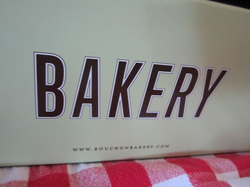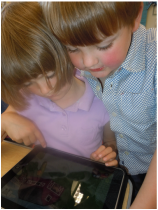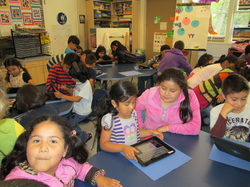Story Buddy 2 is just what it sounds like, a writing application for the iPad, but we are using it this week to make math shape word books. We take a photo of each of our foam 3D-shapes: sphere, hemisphere, cone, pyramid, cube, rectangular prism, cylinder, hexagonal prism, octagonal prism and triangular prism. We use the camera built into the iPad and the photos automatically store to our "camera roll". Then we take photos of objects in our classroom to represent each shape. The fire extinguisher is our cylinder; the globe is our sphere, and so on.
We open our Story Buddy and select "new story" to begin our books. Each student's book is unique as they find different objects around the room to represent the concept. There aren't any pyramids in my room, so I project an image of a pyramid in Egypt on the projector screen and students can take a photo of that. We already know how to write "I see a", so students type that in themselves onto each page as I pass out a study sheet with a list of all the shape words. We work on identifying the beginning sounds in the list of words because we already know the names of the shapes. We have been working on the shape names since the beginning of the year, and we've watched some fun videos that can be found on the Napa ED1STOP website under Discovery Ed streaming called "Math Monsters". These are stories about all the 3D- shapes that bring the concepts to life in a developmentally appropriate context for kinders.
This project takes several days as we work hard to load the pics from our camera rolls, resize by pinching and rotating when needed, and using the style key to make our letter font larger. We are learning key vocabulary that can be used across other iPad apps as well as math vocabulary and the underlying concept of shapes. There is ongoing collaboration as we look at each other's books and help each other to get the stories finished. It's fun to see what other people found in the room to represent a hemisphere! Sharing ideas is part of the process. "I like that your sphere page has a globe and an eyeball; I see that your cylinder page still needs a photo." We are critical friends for each other. That's the kind of friend who is "critical" for your success, not the bossy kind.
Finally, we find a quiet corner of the room to add sound to each page of our new shape book. Mrs. M can use the sound playback feature for assessment to see if we can say the names of the shapes. We are ready to publish our books and store them in our iBooks library. We are building our digital portfolio, and we can be proud of our work and share it with others.
We open our Story Buddy and select "new story" to begin our books. Each student's book is unique as they find different objects around the room to represent the concept. There aren't any pyramids in my room, so I project an image of a pyramid in Egypt on the projector screen and students can take a photo of that. We already know how to write "I see a", so students type that in themselves onto each page as I pass out a study sheet with a list of all the shape words. We work on identifying the beginning sounds in the list of words because we already know the names of the shapes. We have been working on the shape names since the beginning of the year, and we've watched some fun videos that can be found on the Napa ED1STOP website under Discovery Ed streaming called "Math Monsters". These are stories about all the 3D- shapes that bring the concepts to life in a developmentally appropriate context for kinders.
This project takes several days as we work hard to load the pics from our camera rolls, resize by pinching and rotating when needed, and using the style key to make our letter font larger. We are learning key vocabulary that can be used across other iPad apps as well as math vocabulary and the underlying concept of shapes. There is ongoing collaboration as we look at each other's books and help each other to get the stories finished. It's fun to see what other people found in the room to represent a hemisphere! Sharing ideas is part of the process. "I like that your sphere page has a globe and an eyeball; I see that your cylinder page still needs a photo." We are critical friends for each other. That's the kind of friend who is "critical" for your success, not the bossy kind.
Finally, we find a quiet corner of the room to add sound to each page of our new shape book. Mrs. M can use the sound playback feature for assessment to see if we can say the names of the shapes. We are ready to publish our books and store them in our iBooks library. We are building our digital portfolio, and we can be proud of our work and share it with others.



 RSS Feed
RSS Feed
